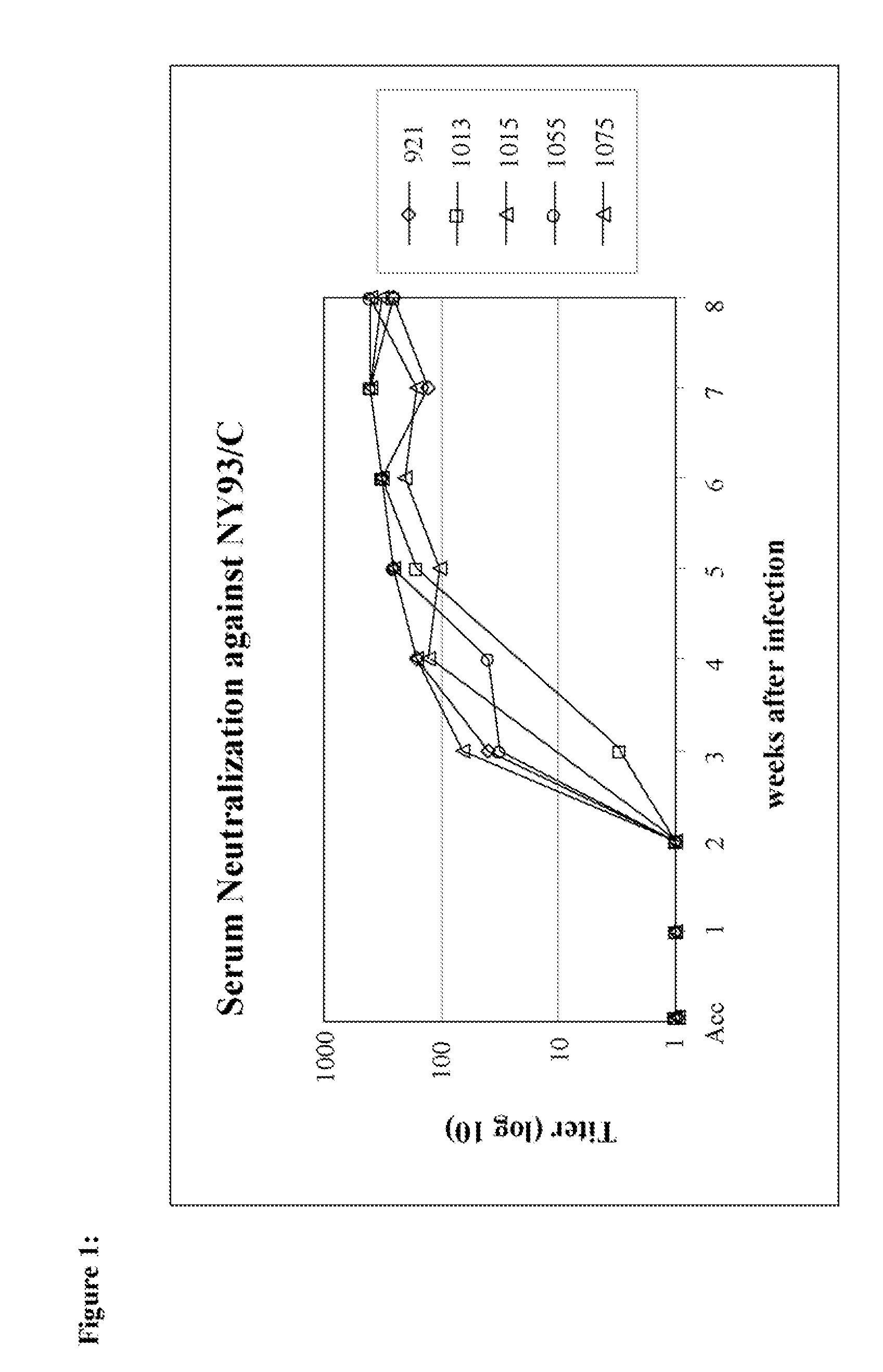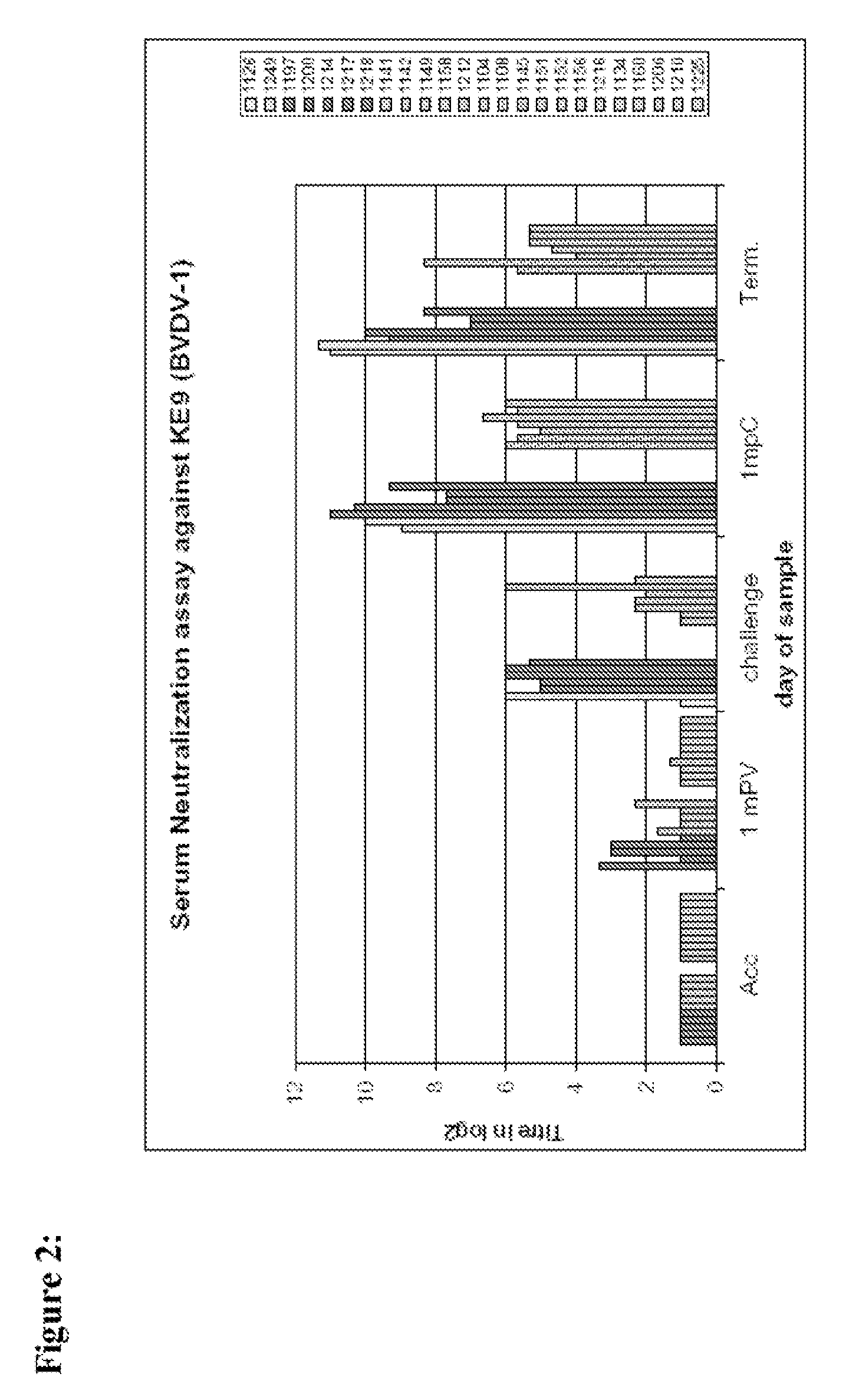Combination vaccine comprising an attenuated bovine viral diarrhea virus
a vaccine and bovine virus technology, applied in the field of animal health, can solve the problems of inability to apply to breeding herds containing pregnant cows, inability to treat and/or prevent infection, and still have drawbacks of bvdv infections, etc., to achieve treatment and/or prophylaxis of cattle, treatment and/or prophylaxis of infections, and the effect of treating and/or prophylaxis of cattl
- Summary
- Abstract
- Description
- Claims
- Application Information
AI Technical Summary
Problems solved by technology
Method used
Image
Examples
example 1
BVDV XIKE-B
Foetopathogenicity Assessment in Pregnant Heifers
[0279]BVDV XIKE-B, an RNase negative mutant of the highly pathogenic BVDV type 2 isolate NewYork'93 / C was recovered from the infectious cDNA clone pKANE40B and showed wild type-like (wt-like) growth characteristics in tissue culture. In animal experiments, the mutant virus was found to be considerably attenuated so that it represented a promising candidate for development of a live attenuated vaccine virus (Meyer et al, 2002). To test whether this attenuated virus is still able to cross the placenta and infect the fetus, pregnant heifers were infected with XIKE-B. As a control, wild type BVDV recovered from cDNA clone pKANE40A was used. The respective virus named XIKE-A expresses an active Erns RNase in the infected cell. The study aimed to assess the safety of XIKE-A and XIKE-B in pregnant animals.
Experimental Design
[0280]Ten pregnant heifers were selected from a BVDV negative herd. The following groups of 5 heifers were i...
example 2
BVDV XIKE-A-NdN
Foetopathogenicity Assessment in Pregnant Heifers
[0337]The Npro gene has been shown to be nonessential for growth of CSFV in tissue culture (Tratschin et al., 1998). Even though a proof for BVDV attenuation in consequence of Npro deletion is still missing, a role of tins protein in the interaction between virus and host seemed to be possible and was actually indicated by recent experiments for CSFV (Mayer et al., 2004, Rüggli et al., 2003). We therefore wanted to investigate, whether the deletion of the major part of the Npro coding sequence leads to a virus that no longer infects the fetus in pregnant heifers. The Npro gene, except for the 5′ terminal 4 codons, was deleted from the full length cDNA clone pKANE40A according to standard procedures. The resulting mutant full length clone was used as template for in vitro transcription and the resulting cRNA was transfected into MDBK cells as described (Meyer et al., 2002). The recovered virus was amplified in tissue cul...
example 3
BVDV XIKE-B-NdN
Foetopathogenicity Assessment in Pregnant Heifers
[0352]To be able to test the potential of a combination of RNase inactivation and Npro deletion with regard to BVDV attenuation and fetal transmission, different BVDV-2 mutants with deletions within the Npro coding region were established based on the infectious cDNA clone pKANE40B, the RNase negative mutant of pKANE40A with a deletion of codon 349. The recovered viruses were analyzed with regard to presence of the desired mutations, the absence of second site mutations in the regions flanking the introduced changes and their growth characteristics in tissue culture. XIKE-B-NdN (V-pK88C), a variant containing a deletion of the complete Npro coding region except for codons 1 to 4 in addition to the RNase inactivating deletion of codon 349 was chosen for an animal experiment since it combined the desired mutations with acceptable growth characteristics. The aim of the study was to assess the safety of a live attenuated BV...
PUM
| Property | Measurement | Unit |
|---|---|---|
| rectal temperature | aaaaa | aaaaa |
| temperature | aaaaa | aaaaa |
| diameter | aaaaa | aaaaa |
Abstract
Description
Claims
Application Information
 Login to View More
Login to View More - R&D
- Intellectual Property
- Life Sciences
- Materials
- Tech Scout
- Unparalleled Data Quality
- Higher Quality Content
- 60% Fewer Hallucinations
Browse by: Latest US Patents, China's latest patents, Technical Efficacy Thesaurus, Application Domain, Technology Topic, Popular Technical Reports.
© 2025 PatSnap. All rights reserved.Legal|Privacy policy|Modern Slavery Act Transparency Statement|Sitemap|About US| Contact US: help@patsnap.com



